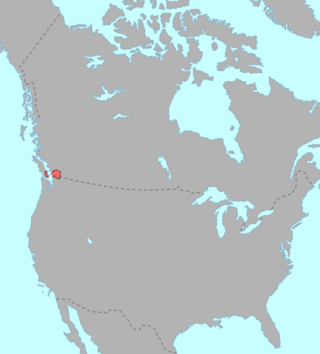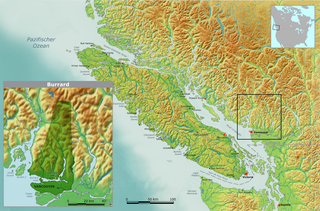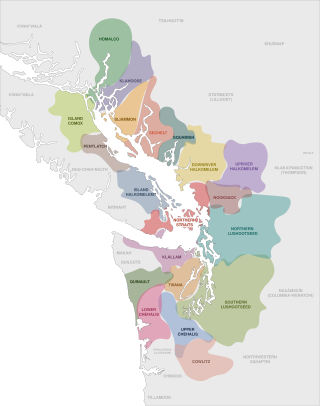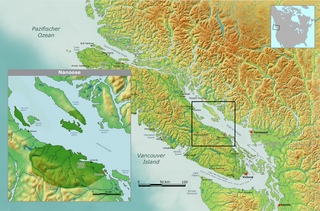Related Research Articles

The Salishan languages are a family of languages of the Pacific Northwest in North America. They are characterised by agglutinativity and syllabic consonants. For instance the Nuxalk word clhp’xwlhtlhplhhskwts’, meaning "he had had [in his possession] a bunchberry plant", has twelve obstruent consonants in a row with no phonetic or phonemic vowels.

The Snuneymuxw First Nation is located in and around the city of Nanaimo on east-central Vancouver Island, British Columbia, Canada. The nation previously had also occupied territory along the Fraser River, in British Columbia.

Kitsilano is a neighbourhood located in the city of Vancouver, British Columbia, Canada. Kitsilano is named after Squamish chief August Jack Khatsahlano, and the neighbourhood is located in Vancouver's West Side along the south shore of English Bay, between the neighbourhoods of West Point Grey and Fairview. The area is mostly residential with two main commercial areas, West 4th Avenue and West Broadway, known for their retail stores, restaurants and organic food markets.

Burrard Inlet is a shallow-sided fjord in the northwestern Lower Mainland, British Columbia, Canada. Formed during the last Ice Age, it separates the City of Vancouver and the rest of the lowland Burrard Peninsula to the south from the coastal slopes of the North Shore Mountains, which span West Vancouver and the City and District of North Vancouver to the north.

False Creek is a short narrow inlet in the heart of Vancouver, separating the Downtown and West End neighbourhoods from the rest of the city. It is one of the four main bodies of water bordering Vancouver, along with English Bay, Burrard Inlet, and the Fraser River. Granville Island is located within the inlet.

Halkomelem is a language of various First Nations peoples of the British Columbia Coast. It is spoken in what is now British Columbia, ranging from southeastern Vancouver Island from the west shore of Saanich Inlet northward beyond Gabriola Island and Nanaimo to Nanoose Bay and including the Lower Mainland from the Fraser River Delta upriver to Harrison Lake and the lower boundary of the Fraser Canyon.
First Nations in British Columbia constitute many First Nations governments and peoples in the province of British Columbia. Many of these Indigenous Canadians are affiliated in tribal councils. Ethnic groups include the Haida, Coast Salish, Kwakwaka'wakw, Gitxsan, Tsimshian, Nisga'a and other examples of the Pacific Northwest Coast cultures, and also various Interior Salish and Athapaskan peoples, and also the Ktunaxa.

The Tsleil-Waututh Nation, formerly known as the Burrard Indian Band or Burrard Inlet Indian Band, is a First Nations band government in the Canadian province of British Columbia. The Tsleil-Waututh Nation ("TWN") are Coast Salish peoples who speak hən̓q̓əmin̓əm̓, the Downriver dialect of the Halkomelem language, and are closely related to but politically and culturally separate from the nearby nations of the Sḵwx̱wú7mesh (Squamish) and xʷməθkʷəy̓əm (Musqueam), with whose traditional territories some claims overlap.

The Musqueam Nation is a First Nation whose traditional territory encompasses the western half of what is now Greater Vancouver, in British Columbia, Canada. It is governed by a band council and is known officially as the Musqueam Indian Band under the Indian Act. "Musqueam" is an anglicization of the Hunquminum name xʷməθkʷəy̓əm, which means "place of the river grass" or "place where the river grass grows".

Say Nuth Khaw Yum Provincial Park, also known as Indian Arm Provincial Park, is a provincial park located in the Lower Mainland of British Columbia, Canada. The park was established on July 13, 1995 by BC Parks to protect the forested mountain terrain of Indian Arm.

Indian Arm is a steep-sided glacial fjord adjacent to the city of Vancouver in southwestern British Columbia. Formed during the last Ice Age, it extends due north from Burrard Inlet, between the communities of Belcarra and the District of North Vancouver, then on into mountainous wilderness. Burrard Inlet and the opening of Indian Arm was mapped by Captain George Vancouver and fully explored days later by Dionisio Alcalá Galiano in June 1792.
The Penelakut First Nation is the band government of the Penelakut people on Vancouver Island in British Columbia, Canada.

The Coast Salish are a group of ethnically and linguistically related Indigenous peoples of the Pacific Northwest Coast, living in the Canadian province of British Columbia and the U.S. states of Washington and Oregon. They speak one of the Coast Salish languages. The Nuxalk nation are usually included in the group, although their language is more closely related to Interior Salish languages.
Naut’sa mawt Tribal Council is a First Nations Tribal Council located in British Columbia, Canada, with offices in Tsawwassen and Nanaimo. NmTC advises and assists its 11-member Nations in the areas of Community Planning, Economic Development, Financial Management, Governance and Technical Services NmTC is also actively involved in fostering dialogue and understanding between its members and their neighbouring communities.

The Nanoose First Nation, also known the Snaw-naw-as First Nation, is a First Nations government located on central Vancouver Island in southwestern British Columbia, Canada, in the vicinity of the community of Nanoose Bay. They are Coast Salish people, and one of the most northern tribes on the east side of Vancouver Island. They speak Hul’q’umi’num’, which is 1 of 3 branches of the Halkomelem dialect spoken from Nanoose to Oregon.

The Sc'ianew First Nation or Beecher Bay First Nation is a First Nations group, governed by a band governmental body of the same name. They are a party involved in the Douglas Treaties and are negotiating a modern treaty as a member of the Te'mexw Treaty Association along with the Malahat, Nanoose, Songhees, and T'Souke Nations. The Sc'ianew First Nation number 261.

In the late 1870s, Squamish and Tsleil-Waututh communities on the North Shore of Burrard Inlet experienced an increase of physical and economic encroachment from the expansion of neighbouring Vancouver. Faced with urbanization and industrialization around reserve lands, Squamish and Tsleil-Waututh traditional economies became increasingly marginalized, while government-imposed laws increasingly restricted Native fishing, hunting, and access to land and waters for subsistence. In response, these communities increasingly turned to participating in the wage-labor economy.
Qayqayt was the name of an indigenous community located in the Brownsville area of Surrey, British Columbia. The community was part of the Kwantlen First Nation and Musqueam Indian band respectively. It was used as a site for fishing by many different First Nations, including the Kwantlen, Musqueam, Squamish, Katzie, Kwikwetlem, Semiahmoo, Tsleil-waututh, and Tsawwassen.
References
- 1 2 3 4 Hul’q’umi’num’ / Halq'eméylem / hən̓q̓əmin̓əm The First Peoples Language Map of British Columbia
- ↑ Tsleil Waututh Nation - People of the Inlet website, FAQ
- ↑ "Musqueam A Living Culture website, Language and Culture page".
- ↑ Central Coast Salish, in Handbook of North American Indians, vol. 7,: Northwest Coast Pp. 453-480. Wayne Suttles, Washington, D.C.: Smithsonian Institution
- ↑ "The Territory of the Semiahmoo". www.surreyhistory.ca.